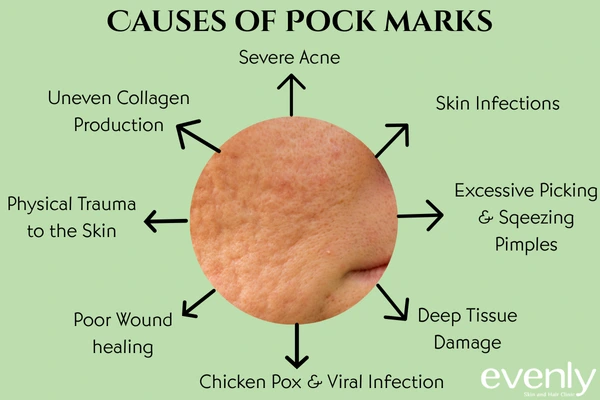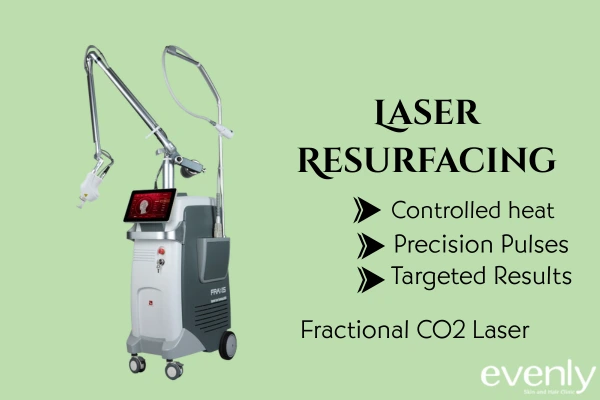Up to 25% OFF on Selected Treatments
-
Treatments
Acne and Scar
Pigmentation
Laser Hair Reduction
Dermato-surgery
Body
Anti Aging
Skin Rejuvenation
Others
- Clinics
- Blogs
Treatments
When you look in the mirror, do you see small, deep scars on your face that resemble tiny hollows? These are known as pockmarks. They are caused by severe acne, chicken pox, smallpox, or other inflammatory skin conditions. They leave behind depressions that can give the skin a rough, uneven texture. If you delay the treatment, it can lead to a lifelong struggle with this skin condition. Here we will discuss what pockmarks are, explore their causes, and discuss effective treatments to restore your skin’s smoothness and radiance.
Pockmarks are small, ice-pick concave scars that form on the skin’s surface, creating an uneven texture. Unlike other types of scars, pockmarks are characterised by their depth and sharp edges, which can make them particularly noticeable. They are most commonly found on the face but can also appear on other body parts, such as the back or chest.
These scars occur when the skin’s deeper layers, such as the dermis or subcutaneous tissue, are damaged by an infection like chicken pox or smallpox. The body tries to repair this damage by producing collagen, but collagen often forms unevenly, leading to the creation of a pockmark. Pockmarks can vary in size, from small pinpoints to larger depressions, and can be challenging to treat due to the depth of the damage. Sometimes, it also varies in colour.
There are primarily three types of pockmarks:
Pockmarks on the face or any other body part can result from various skin conditions like acne, infections, and pustules. Understanding its causes on the face helps in preventing their formation.

The face is the most common area affected by pockmarks. The cheeks, forehead, chin, and nose are particularly susceptible due to a higher concentration of oil glands. The formation of pockmarks on the face or any other body parts is a complex process that involves several stages:
Pock marks can be a lasting problem if not treated. But don’t worry, there are several effective options available at Evenly to help restore your skin’s smoothness and reduce the appearance of these scars. Our dermatologist can figure out the best pock marks treatment for you after checking your skin. Based on this, they can recommend the right pock marks treatment or a combination of treatments. Let’s explore the pock marks treatments offered by Evenly.

Laser resurfacing is a popular and effective treatment for pockmarks on the face. This procedure uses concentrated light energy to gently remove damaged skin layers and stimulate the production of new collagen. One of the most advanced techniques is fractional CO2 laser resurfacing. It excels at treating deep pockmarks by penetrating deep skin layers to promote healing and reduce scar visibility. This precision treatment is FDA-approved, safe for various skin tones, and minimises side effects. It not only diminishes the appearance of pockmarks but also improves overall skin texture and tone.
The Erbium YAG laser is another powerful treatment for treating pock marks, especially for those with sensitive skin. This laser treatment focuses on precise ablation of the skin’s surface layers, which leads to the formation of new, healthy skin cells. It is particularly effective in reducing the appearance of superficial scars, fine lines, and wrinkles while also improving the skin’s texture. The Erbium YAG laser offers a shorter recovery time compared to other laser treatments, making it a convenient option for those seeking effective results with minimal downtime.
Platelet-rich plasma is an advanced pock marks treatment that utilises the body’s natural healing powers to treat. PRP is derived from the patient’s own blood, which is processed to concentrate the platelets—cells rich in growth factors that promote healing and tissue regeneration. When injected into areas with pockmarks, PRP stimulates collagen production and accelerates the skin’s natural repair processes, helping to fill in scars and improve overall skin quality. PRP can be used alone or in combination with other treatments, such as microneedling, for enhanced results.
Well known as a collagen-boosting treatment, this minimally invasive treatment involves creating a tiny puncture in the skin, simultaneously stimulating collagen production. This helps to fill the pockmarks and improve skin texture. For improved results, it can be combined with platelet-rich plasma treatment.
If your pockmarks are not very deep, our specialists may recommend microdermabrasion as a treatment option. This non-invasive treatment uses tiny abrasive particles to gently buff away the top layer of the skin. It’s like an exfoliation for your skin to improve the overall texture and tone of your skin, making those less severe pockmarks less noticeable. It not only removes dead skin cells but also helps to clean out pores.
Another recommended treatment for pockmarks on the face is chemical peels. This treatment involves applying a special chemical solution to the skin to exfoliate the outer layer, stimulating collagen production, and reducing the appearance of pockmarks. These peels can be recommended for shallow pockmarks, and multiple sessions may be required for optimal results.
It’s essential to consult with a dermatologist to determine the best peel strength for your skin type and the severity of your scars.
Must read: Top 6 Chemical Peel Benefits for Radiant Skin
Whether you’re dealing with pockmarks on your face or other areas of your body, it’s essential to seek appropriate treatment to get rid of them. Without appropriate treatment, you can’t eliminate it. At Evenly Skin and Hair Clinic, our experienced dermatologists offer personalised treatment plans and provide a dedicated treatment for pock marks.
For health-related information, follow us on Instagram.
Click here for an online consultation.
Is there a risk of pockmarks worsening over time?
Pockmarks generally do not worsen over time, but they can become more noticeable with aging as the skin loses elasticity.
Are pockmarks permanent?
Pockmarks can be permanent if left untreated, but there are various treatments available to reduce their appearance.
How effective is laser resurfacing for pockmarks?
Laser resurfacing is highly effective, especially for deep pockmarks, as it stimulates collagen production and removes damaged skin layers.
Are pockmarks more common in certain skin types?
Pockmarks can occur in all skin types but may be more noticeable in individuals with darker or more sensitive skin.
How does sun exposure affect pockmarks?
Sun exposure can darken pockmarks and slow down the healing process, so it’s important to use sunscreen.
Is it necessary to see a dermatologist for pockmark treatment?
Yes, a dermatologist can provide professional advice and recommend the most effective treatments for your specific skin condition.
We hope this information has been helpful. If you have any skin and hair-related questions or would like to discuss personalized solutions, please reach out to us at 7337899030. Our team of experts is dedicated to providing personalized care that meets your unique needs. Take the first step towards a healthier, more confident you by scheduling a consultation with us today. Your journey to vibrant skin and stronger hair begins here.
Book an Appointment
Start your journey to healthy skin and hair today.
Leave a Comment